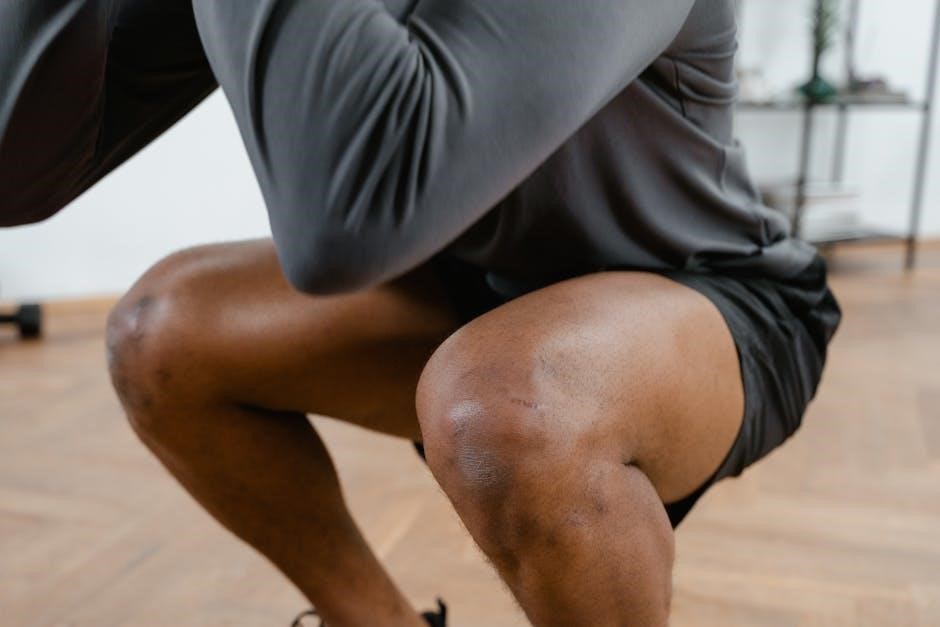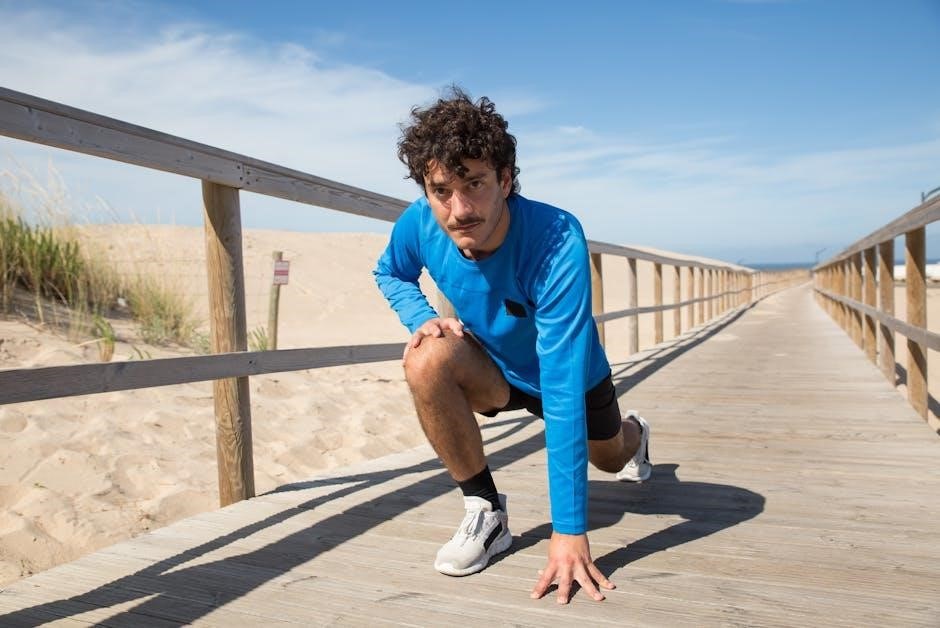Total Knee Replacement Exercises: A Post-Operative Guide
This guide offers a structured approach to post-operative exercises following a total knee replacement (TKR)․ It provides valuable information and guidelines to aid in your rehabilitation journey․ The exercises detailed herein are designed to improve range of motion, reduce pain, and promote strength recovery․
Undergoing a total knee replacement (TKR) is a significant step towards regaining mobility and alleviating pain․ However, the success of the surgery hinges greatly on a dedicated and well-structured post-operative exercise program․ This program is crucial for restoring knee function, improving strength, and facilitating a return to daily activities․ Post-TKR exercises are not merely about physical recovery; they are also about regaining confidence and independence․
The exercises prescribed are designed to address several key aspects of recovery․ Firstly, they aim to improve range of motion, allowing for greater flexibility and ease of movement in the knee joint․ Secondly, they focus on strengthening the muscles surrounding the knee, including the quadriceps, hamstrings, and calf muscles, providing essential support and stability․ Thirdly, the exercises help to reduce swelling and pain, common post-operative symptoms that can hinder progress․
This guide provides a comprehensive overview of the exercises typically recommended after TKR, outlining the different phases of rehabilitation and the specific exercises appropriate for each stage․ It also emphasizes the importance of adhering to the recommended frequency and intensity of exercises, as well as seeking guidance from a physical therapist to ensure proper form and prevent complications․ Remember, consistency and patience are key to achieving a successful outcome and enjoying the long-term benefits of your knee replacement․
Phase 1: Immediate Post-Operative Exercises (0-2 Weeks)
The initial two weeks following total knee replacement surgery are critical for laying the foundation for a successful recovery․ Phase 1 focuses on controlling pain and swelling, regaining initial range of motion, and activating key muscles around the knee․ The exercises in this phase are gentle and designed to be performed while in bed or seated․ The primary goals are to prevent stiffness, promote circulation, and begin the process of regaining quadriceps control․ This phase requires diligence and adherence to your physical therapist’s instructions;
During this period, it’s essential to prioritize pain management to enable you to actively participate in the exercises․ Regular use of prescribed pain medication, along with ice packs applied to the knee, will help to minimize discomfort․ Remember to elevate your leg whenever possible to reduce swelling․ The exercises should be performed frequently throughout the day, typically every hour while you are awake, to maximize their effectiveness․

It’s important to listen to your body and avoid pushing yourself too hard․ The exercises should be challenging but not painful․ As you progress, you may gradually increase the number of repetitions and sets․ Maintaining open communication with your physical therapist is crucial during this phase, allowing them to monitor your progress and adjust the exercise program as needed․ Consistent effort in Phase 1 will set the stage for a smoother and more effective rehabilitation journey․
Key Exercises in Phase 1: Ankle Pumps, Quad Sets, Heel Slides
Phase 1 post-operative recovery after total knee replacement focuses on gentle exercises․ These exercises are pivotal for initiating the healing process and preventing complications․ Three essential exercises during this period are Ankle Pumps, Quad Sets, and Heel Slides․ These exercises target different aspects of knee rehabilitation, from promoting circulation to activating key muscle groups․ Each exercise should be performed with attention to proper form and within your pain tolerance․
Ankle Pumps involve repeatedly pointing your toes up towards your shin and then down away from your shin․ This simple exercise helps improve blood flow in the lower leg, reducing the risk of blood clots․ Quad Sets focus on activating the quadriceps muscle․ To perform this, tighten the muscles on the front of your thigh while keeping your leg straight, pressing the back of your knee down into the bed․ Hold for a few seconds and repeat․ Heel Slides assist in regaining knee flexion․ While lying on your back, slowly slide your heel towards your buttocks, bending your knee as far as comfortable․ Then, gently straighten your leg back to the starting position․
Consistency is key․ Aim to perform these exercises multiple times a day, following the guidance of your physical therapist․ They will ensure you are performing them correctly and progressing appropriately․ Remember, these exercises are designed to be a starting point, and your rehabilitation program will evolve as you heal and regain strength․
Phase 2: Early Rehabilitation (2-4 Weeks)
Phase 2 of rehabilitation following total knee replacement, typically spanning weeks 2 to 4 post-surgery, marks a progression in your recovery journey․ The primary goals during this phase are to enhance range of motion, improve muscle strength, and increase your overall functional independence․ This involves building upon the foundational exercises introduced in Phase 1 and gradually incorporating more challenging activities․
During this period, you’ll likely be working towards achieving greater knee flexion and extension․ Consistent effort and adherence to your physical therapist’s recommendations are crucial for optimal progress․ Pain management remains a key consideration, ensuring that you can actively participate in exercises without exacerbating discomfort․ It’s important to strike a balance between pushing yourself and respecting your body’s limitations․
Exercises in Phase 2 may include gentle stretching, assisted range of motion exercises, and the introduction of light resistance training․ The focus is on restoring normal movement patterns and building a solid base for more advanced activities in subsequent phases․ Remember to communicate openly with your physical therapist about any pain or limitations you experience․ They can adjust your program to ensure it remains safe and effective as you continue to heal and regain strength․
Strengthening and Range of Motion Exercises in Phase 2
Phase 2 of post-operative rehabilitation emphasizes a combination of strengthening and range of motion exercises to facilitate recovery․ Heel slides, progressing from assisted to independent, continue to be essential for improving knee flexion․ Standing hamstring curls, performed with support as needed, gently engage the muscles at the back of the thigh, contributing to knee stability․
Mini-squats, executed with caution and proper form, begin to rebuild strength in the quadriceps and gluteal muscles․ Short arc quads involve extending the knee against gravity or light resistance, further targeting the quadriceps․ Stationary cycling, initiated with minimal resistance and low seat height, promotes circulation and increases range of motion in a controlled manner․ As pain subsides, the intensity and duration of cycling can be gradually increased․
Straight leg raises, performed in multiple directions, strengthen the hip flexors and core muscles, which are important for overall stability․ Throughout these exercises, maintaining proper alignment and avoiding compensatory movements is vital․ Listen to your body, stop if you experience sharp pain, and consult with your physical therapist for guidance on proper technique and progression․
Importance of Pain Management During Exercise
Effective pain management is critical for successful rehabilitation after total knee replacement․ Pain can significantly hinder participation in exercises, impede progress, and negatively impact overall recovery․ A multi-faceted approach is often necessary, combining medication, modalities, and activity modification․
Adhering to prescribed pain medication regimens, as directed by your physician, is crucial for maintaining a manageable pain level․ Timing medication appropriately, such as before exercise sessions, can optimize comfort and allow for better engagement․ Cold therapy, applied after exercise, can reduce inflammation and alleviate pain․ Elevation of the leg can also minimize swelling and discomfort․
It is important to communicate openly with your physical therapist and physician about your pain levels․ They can adjust the exercise program, explore alternative pain management strategies, and address any underlying issues contributing to pain․ Remember, some discomfort is normal during rehabilitation, but sharp, escalating pain should be avoided․ Learning to differentiate between tolerable discomfort and pain that signals potential harm is essential․ Pushing through excessive pain can lead to setbacks and delay recovery․
Progression to Functional Exercises: Sit-to-Stand, Stationary Bike
As your strength and range of motion improve, you will progress to functional exercises that mimic daily activities․ Sit-to-stand exercises are essential for regaining independence and confidence in performing basic tasks․ Start by using a chair with armrests for support, gradually decreasing reliance on them as your strength increases․ Focus on maintaining proper form, pushing through your heels, and engaging your quadriceps muscles․

The stationary bike is an excellent tool for improving knee flexion, cardiovascular fitness, and lower extremity endurance․ Begin with low resistance and short durations, gradually increasing both as tolerated․ Ensure proper seat height to avoid excessive strain on the knee joint․ Pedal smoothly and avoid any jerky movements․
These exercises should be performed under the guidance of a physical therapist, who can monitor your progress, provide feedback on your technique, and adjust the program as needed․ Listen to your body and avoid pushing through pain․ Gradual progression is key to preventing setbacks and achieving optimal functional outcomes․ Remember to maintain consistent effort and adhere to your exercise schedule for the best results․
Long-Term Rehabilitation and Maintaining Knee Health
Long-term rehabilitation is crucial for maintaining the benefits gained from your initial post-operative recovery and ensuring optimal knee health․ This phase focuses on incorporating regular exercise into your lifestyle, managing pain effectively, and preventing future complications․ Continue performing strengthening and range-of-motion exercises, gradually increasing the intensity and duration as tolerated․ Consider activities such as walking, swimming, or cycling to maintain cardiovascular fitness and overall well-being․
Pay close attention to your body and avoid activities that cause excessive pain or swelling in the knee joint․ Maintain a healthy weight to reduce stress on the joint․ Engage in low-impact exercises to protect the knee․ It is important to continue with your home exercise program on a regular basis․
Regular follow-up appointments with your physical therapist are essential for monitoring your progress, addressing any concerns, and modifying your exercise program as needed․ They can also provide guidance on proper body mechanics and strategies for preventing falls․ By prioritizing long-term rehabilitation and adopting a healthy lifestyle, you can maximize the longevity of your knee replacement and enjoy an active, pain-free life․

When to Consult a Physical Therapist
Consulting a physical therapist is crucial throughout your total knee replacement recovery journey․ Initially, a physical therapist guides you through the immediate post-operative phase, establishing a safe and effective exercise program tailored to your specific needs․ They monitor your progress, adjust exercises accordingly, and address any pain or swelling․

Beyond the initial phase, seeking physical therapy is essential if you experience persistent or worsening pain, limited range of motion, or difficulty performing daily activities․ If you notice increased stiffness, instability, or any signs of infection, promptly consult a physical therapist․ They can assess your condition, identify underlying issues, and implement appropriate interventions to optimize your recovery․
Moreover, a physical therapist can provide guidance on returning to specific activities or sports, ensuring you do so safely and effectively․ They can also educate you on long-term strategies for maintaining knee health and preventing future problems․ Don’t hesitate to seek professional help from a physical therapist at any stage of your recovery; their expertise can significantly enhance your outcome and overall quality of life․ They provide an individualized plan tailored to you․
